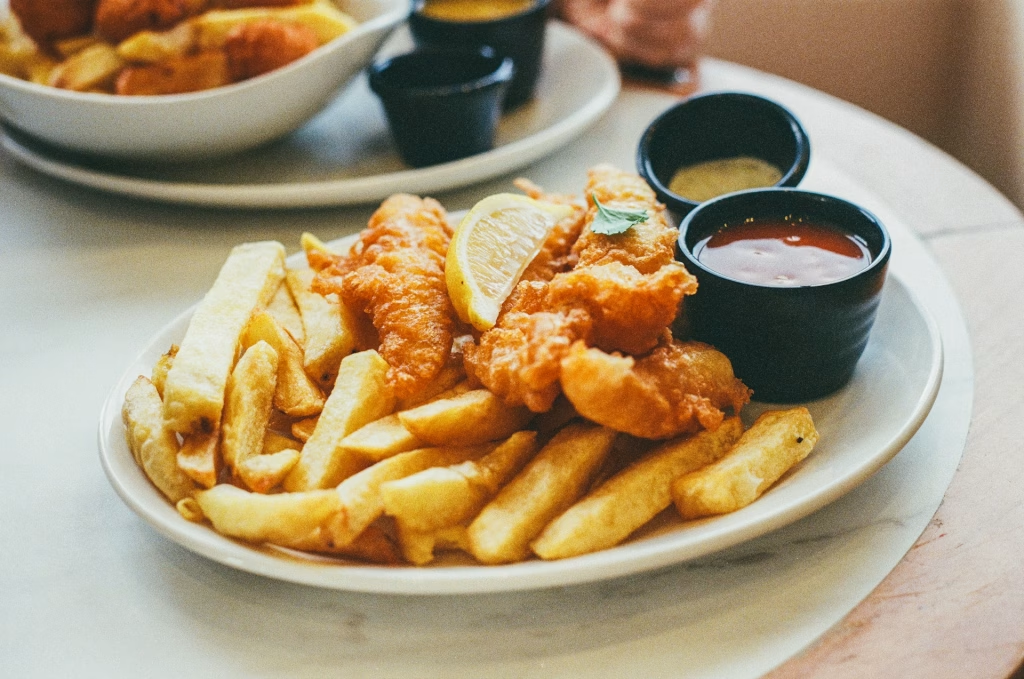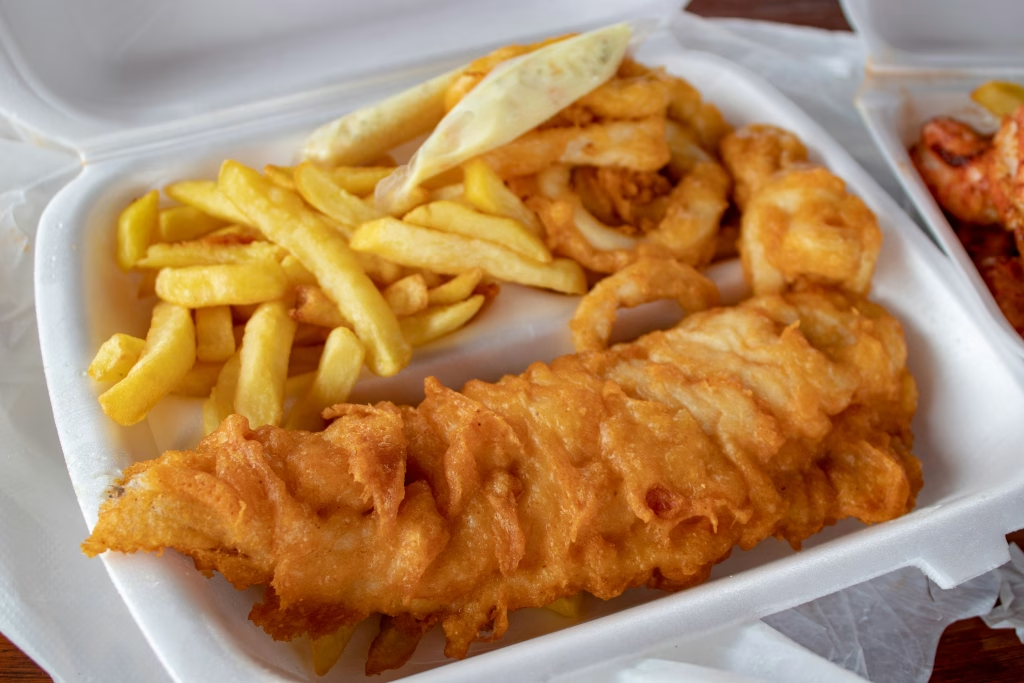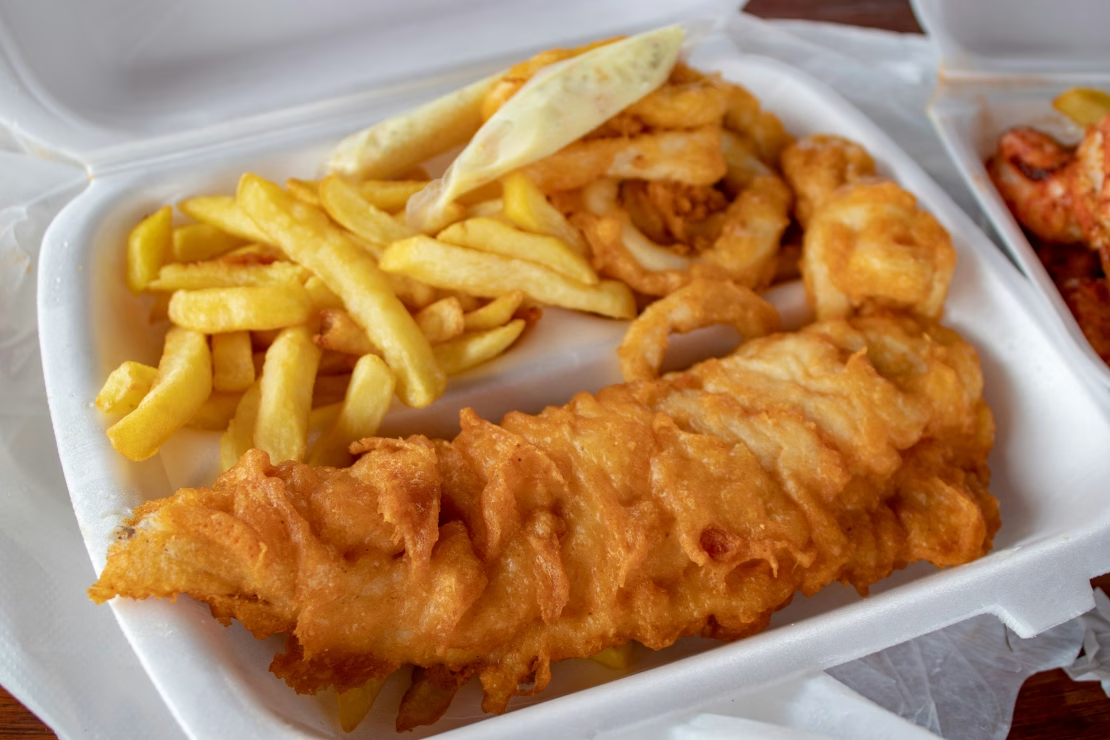British Fish and Chips is more than just a beloved comfort food, it’s a symbol of national pride, culinary tradition, and coastal nostalgia in the United Kingdom.
This golden duo of crispy battered fish and chunky fried potatoes has stood the test of time, from humble seaside shacks to gourmet gastro pubs.
In this article, you’ll learn how to make an authentic British Fish and Chips recipe at home, complete with traditional touches, expert tips, and a dive into its rich history.
Table of Contents
Ingredients
For the Fish Batter:
- 1 ½ cups (190g) all-purpose flour, plus extra for dusting
- 1 tsp baking powder
- 1 tsp salt
- 1 cup (240ml) cold sparkling water (or cold beer for traditional flavor)
- ½ tsp turmeric (optional, for golden color)
- Vegetable oil for deep frying
For the Fish:
- 4 skinless cod or haddock fillets (about 6 oz each)
- Salt and pepper to season
For the Chips:
- 4 large russet potatoes
- Oil for deep frying (can be the same as for fish)
For Serving:
- Malt vinegar
- Salt
- Lemon wedges
- Tartar sauce
- Mushy peas (optional, traditional accompaniment)
Serves
Serves: 4 people
Preparation time: 25 minutes
Cooking time: 35 minutes
Total time: 60 minutes
Step-by-Step Instructions
1. Prepare the Potatoes
- Peel the potatoes and cut them into thick chips—about 1 cm to 1.5 cm in width.
- Rinse them under cold water to remove excess starch.
- Place the chips in a large bowl of cold water and soak them for at least 30 minutes (or up to 2 hours) for better texture.
2. Parboil the Chips (Traditional Double-Fry Method)
- Bring a pot of salted water to a boil and simmer the chips for 4-5 minutes until just tender but not falling apart.
- Drain carefully and let them dry completely on a clean kitchen towel. Moisture causes oil splatter, so drying is crucial.
3. Make the Batter
- In a bowl, mix the flour, baking powder, turmeric, and salt.
- Slowly whisk in the cold sparkling water or beer until the batter is smooth and thick enough to coat the back of a spoon.
- Let the batter rest while heating the oil.
4. Preheat the Oil
- Heat oil in a deep fryer or deep, heavy-bottomed pan to 180°C (355°F). Use a thermometer for accuracy.
- Make sure there’s enough oil to submerge the fish and chips, but do not fill the pot more than halfway.
5. First Fry for Chips
- Carefully add the dried, parboiled chips in small batches to the hot oil.
- Fry for 4-5 minutes until pale and soft but not yet golden.
- Remove and drain on paper towels. Set aside.
6. Batter and Fry the Fish
- Pat fish fillets dry with paper towels and season with salt and pepper.
- Lightly dust each fillet with flour to help the batter stick.
- Dip the fillets into the batter, ensuring an even coating.
- Gently lower into the oil, one or two at a time, to avoid crowding.
- Fry for 6-8 minutes, turning once, until golden brown and crispy.
- Remove and drain on a wire rack or paper towels.
7. Second Fry for Chips
- Increase oil temperature slightly to 190°C (375°F).
- Fry the chips again for 3-5 minutes until golden and crispy on the outside.
- Drain well and season with salt.

Serving Suggestions
Serve British Fish and Chips hot and fresh with:
- Malt vinegar drizzled over the chips
- A generous scoop of homemade or store-bought tartar sauce
- Lemon wedges for the fish
- A side of traditional mushy peas
- Pickled onions or gherkins for added tang
For a pub-style experience, wrap the fish and chips in greaseproof paper or newspaper (lined with food-grade paper) for nostalgic charm.
Tips for Perfect British Fish and Chips
- Cold Batter is Key: Keep your batter cold. It helps create a crisp, bubbly crust.
- Double-Fry the Chips: This method gives the chips a fluffy interior and a crunchy exterior.
- Use the Right Fish: Cod and haddock are the classic choices due to their firm texture and mild flavor.
- Don’t Crowd the Pan: Fry in small batches to maintain oil temperature and crispiness.
- Drain Well: Use a wire rack instead of paper towels for better airflow and less sogginess.
- Season Immediately: Salt the chips right after frying to ensure it sticks.
- Use Beer or Sparkling Water: Both create a light, airy batter due to carbonation.
Healthier Alternatives
If you’re craving British Fish and Chips but want a healthier twist:
Baked Fish:
- Instead of deep frying, brush the battered or breaded fish with oil and bake at 220°C (425°F) for 20 minutes, flipping once.
Air-Fried Chips:
- Air fry soaked and seasoned chips at 200°C (390°F) for 20-25 minutes, shaking halfway through.
Whole Wheat Batter:
- Substitute some all-purpose flour with whole wheat flour for extra fiber.
Grilled Fish:
- Marinate fillets with herbs, lemon juice, and olive oil, then grill for a lighter option.
Oven-Roasted Chips:
- Bake hand-cut chips with a little olive oil and sea salt for a healthier, lower-fat version.
Creative Variations
Though traditional is timeless, here are some fun twists:
1. Spicy Fish and Chips
Add chili powder or paprika to the batter for a subtle heat kick.
2. Beer and Herb Batter
Mix chopped parsley, thyme, or dill into the batter for a fragrant upgrade.
3. Curry Chips
Serve with a side of British-style curry sauce for a Northern England favorite.
4. Sweet Potato Chips
Use sweet potatoes instead of regular ones for a sweeter, nutrient-rich side.
5. Fish Tacos (UK Fusion)
Use battered fish pieces in soft tortillas with mushy peas, tartar sauce, and shredded lettuce.
Common Mistakes to Avoid
- Wet Fish: Moisture ruins batter adhesion and creates splatter. Always pat fish dry.
- Warm Batter: Warm batter results in dense coating—keep it chilled.
- Overcrowding the Oil: It lowers oil temperature, leading to greasy, soggy results.
- Undercooked Chips: Skipping the parboil or first fry leads to hard, undercooked interiors.
- Thick Batter: Batter should be like pancake batter—thick but pourable.
- Wrong Oil Temperature: Use a thermometer. Too hot, and it burns; too cold, and it’s greasy.
- Using Thin Fish Fillets: Thin pieces dry out quickly and become rubbery.
- Skipping Seasoning: Always season both fish and chips, inside and out.
- Reusing Old Oil: Used oil can affect the flavor and color—use fresh or filtered oil.
- Serving Late: Fish and chips are best served immediately; waiting ruins the crispness.
History of British Fish and Chips
The Humble Origins
The story of British Fish and Chips dates back to the 19th century, during the Industrial Revolution. Fried fish was introduced to Britain by Jewish immigrants from Portugal and Spain in the 1600s, but it was the combination with fried potatoes that created the iconic pairing. Fried potatoes were already popular among the working class in Belgium and France, and they slowly made their way into the UK.

Working-Class Staple
By the late 1800s, fish and chips became a staple meal for Britain’s working class. Cheap, filling, and available in almost every town, they were sold wrapped in newspaper and eaten with the hands—no forks required. The first official fish and chip shop opened in London in 1860, followed by others in cities like Manchester, feeding hungry factory workers and coal miners.
War-Time Hero
Fish and chips gained legendary status during both World Wars. Unlike many other foods, fish and potatoes were never rationed, making them a morale-boosting national treasure. Winston Churchill famously referred to fish and chips as “the good companions.” Post-war, they continued to evolve into a cultural icon, with Friday night fish and chips becoming a cherished British tradition.
FAQs about British Fish and Chips
1. What kind of fish is best for British Fish and Chips?
Cod and haddock are traditional, but pollock or plaice are acceptable substitutes.
2. Can I use frozen fish?
Yes, but thaw completely and pat dry to prevent soggy batter.
3. What’s the secret to crispy batter?
Cold, fizzy batter made with sparkling water or beer helps create a light, crunchy texture.
4. Is it necessary to double-fry the chips?
For authentic texture—yes. It ensures a fluffy interior and crispy exterior.
5. Can I reuse the oil?
You can reuse oil 2–3 times if it’s filtered and stored properly, but fresh oil gives the best flavor.
6. What vinegar is used for chips?
Malt vinegar is the traditional choice due to its tangy depth.
7. Are fish and chips gluten-free?
Not traditionally. Use gluten-free flour and beer or water for a celiac-friendly version.
8. How do I store leftovers?
Store in an airtight container in the fridge. Reheat in an oven to revive crispness.
9. What’s the best side dish?
Mushy peas, pickled onions, or a small salad are classic accompaniments.
10. Can I make this in an air fryer?
Yes—use the air fryer for chips and bake or air-fry the battered fish for a lighter version.
British Fish and Chips is more than a recipe, it’s an edible embodiment of history, tradition, and comfort. Whether enjoyed by the seaside on a breezy day or recreated at home for a Friday night treat, its crisp golden batter and hearty chips deliver nostalgic satisfaction every time. With the tips, alternatives, and step-by-step guide shared above, you can recreate this classic dish just like a British chippy, no passport required.
So grab your cod, heat up the fryer, and enjoy a plate of piping hot British Fish and Chips that’s as authentic as it gets.


